Ceiling cracks can be more than just cosmetic concerns they often indicate underlying issues that could affect the safety and stability of your home. Identifying these cracks and understanding their causes is vital, especially in the UK, where the age of properties, climate, and soil types can exacerbate structural problems. This comprehensive guide explores types of ceiling cracks with pictures, their causes, risks, and solutions, helping homeowners take proactive steps to protect their properties.
What Are Ceiling Cracks?
Ceiling cracks are visible lines or fissures that appear on a ceiling’s surface, often due to material stress, environmental factors, or structural shifts. While some cracks are harmless and cosmetic, others can be early signs of serious structural issues. Recognizing the different types of cracks can help homeowners decide when to undertake DIY repairs or call a professional.
In the UK, older homes with period features like lath-and-plaster ceilings or newer properties with drywall are susceptible to cracks due to natural settling, moisture, or environmental changes. Some cracks are caused by seasonal temperature fluctuations, while others result from foundational movement, water damage, or structural strain.
10 Types of Ceiling Cracks with Pictures
1. Hairline Ceiling Cracks
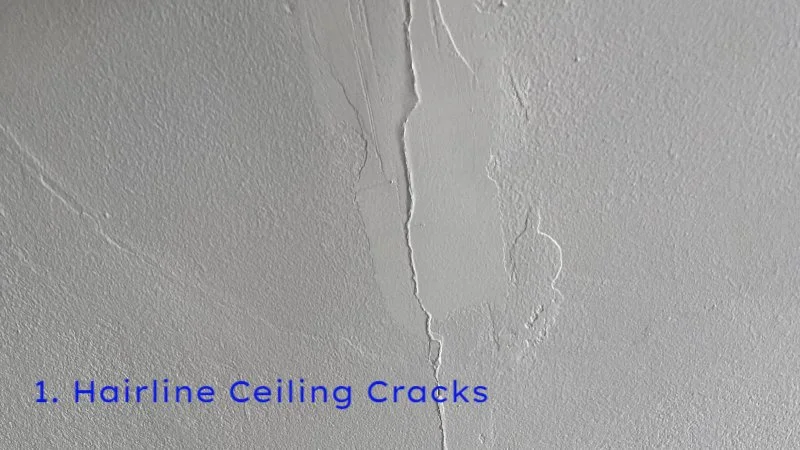
Hairline cracks are thin, barely noticeable fissures that often appear randomly or along the seams of drywall or plasterboard.
Causes:
- Natural Settling: New-build homes often develop hairline cracks within the first few years as the structure adjusts to its surroundings.
- Material Shrinkage: The drying and shrinking of plaster or paint during construction can cause tiny cracks.
- Temperature Variations: The UK’s variable weather leads to the expansion and contraction of materials, resulting in minor cracks.
Risk Level:
Low. These cracks are typically cosmetic and don’t indicate structural concerns. However, they should be monitored for changes in size or color, which could signal underlying dampness or stress.
Solutions:
- Fill the cracks with a flexible filler or decorator’s caulk.
- Sand and repaint the area with durable ceiling paint to restore a smooth finish.
- Monitor the cracks to ensure they don’t worsen over time.
2. Spiderweb Ceiling Cracks
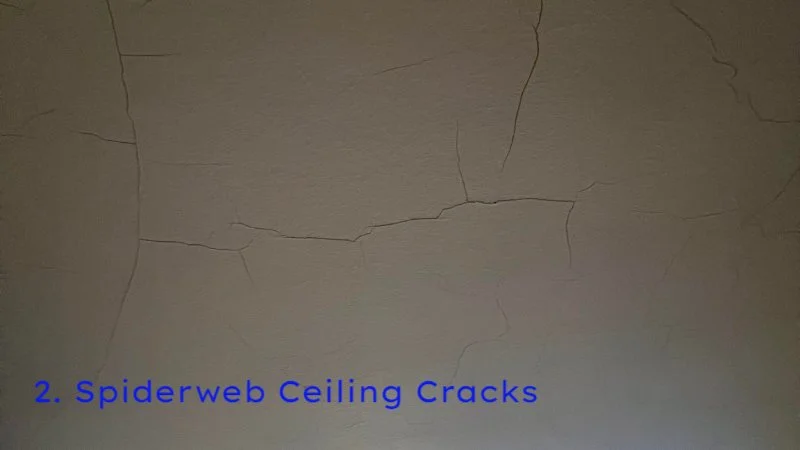
Spiderweb cracks radiate out from a central point, resembling the spokes of a web. These cracks are often found in older UK homes with plaster ceilings.
Causes:
- Structural Stress: Central stress points in ceilings can cause spiderweb cracks.
- Moisture Damage: High humidity levels, common in kitchens and bathrooms, can weaken plaster, causing cracks.
- Improper Plaster Application: Uneven plastering can lead to cracking over time.
Risk Level:
Low to Medium. While often cosmetic, widespread spiderweb cracks may indicate structural stress or moisture issues.
Solutions:
- Improve ventilation in high-humidity areas.
- Repair cracks using plaster or filler, followed by repainting.
- If cracks spread or deepen, consult a professional for structural assessment.
3. Straight Ceiling Cracks
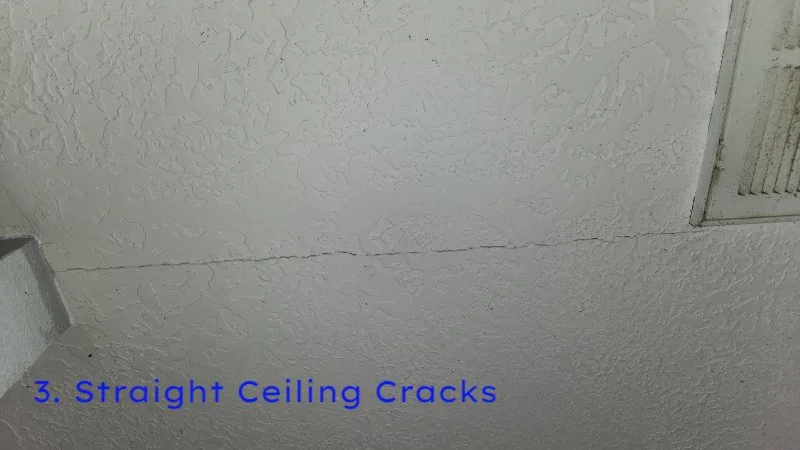
Straight cracks run in a linear pattern, often along the seams of plasterboard or drywall.
Causes:
- Drywall Tape Separation: Poorly applied tape can loosen, causing cracks along the seams.
- Temperature Changes: Seasonal fluctuations in the UK cause materials to expand and contract, leading to cracks.
- Natural Settling: Structural adjustments in newer homes can create straight cracks.
Risk Level:
Medium. These cracks are generally cosmetic but can worsen if left untreated.
Solutions:
- Re-tape the affected area using high-quality drywall tape.
- Apply joint compound, sand smooth, and repaint.
- Monitor for signs of structural stress, such as widening cracks.
4. Diagonal Ceiling Cracks
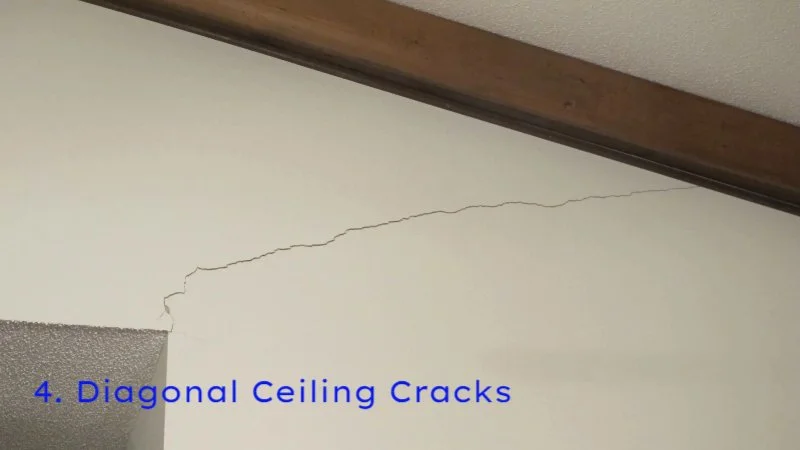
Diagonal cracks are angular and often appear near corners or load-bearing beams.
Causes:
- Foundation Movement: Uneven settling of foundations, particularly in clay-heavy soils found in parts of the UK, can cause stress on ceilings.
- Structural Shifts: Nearby construction or heavy loads can create diagonal cracks.
Risk Level:
High. These cracks often indicate significant structural issues requiring immediate attention.
Solutions:
- Consult a structural engineer to assess foundational stability.
- Address the root cause, such as underpinning the foundation.
- Repair the cracks using professional-grade materials.
5. Curved or Arched Ceiling Cracks
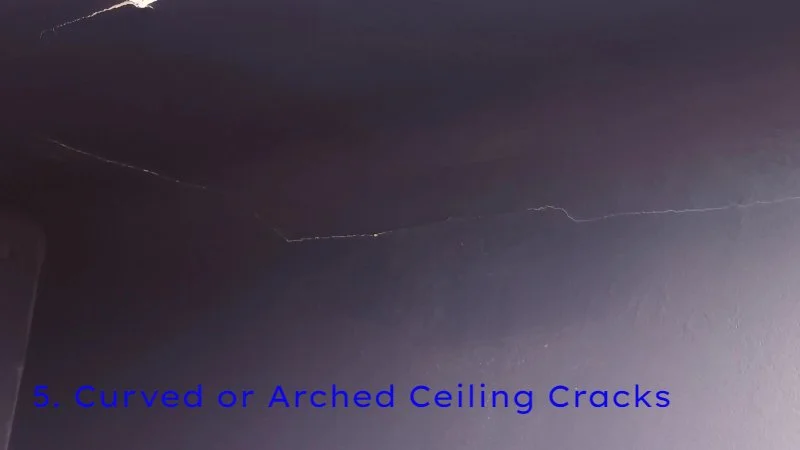
Curved cracks form gentle bends rather than straight lines and are often found near the edges of ceilings.
Causes:
- Foundation Settling: Gradual settling of older homes can lead to stress along ceiling edges.
- Material Movement: Stress at joints or areas with concentrated weight creates curved cracks.
Risk Level:
Medium. Though not immediately concerning, these cracks should be monitored for changes.
Solutions:
- Regularly inspect the cracks for growth or deepening.
- Repair using a flexible plaster filler to accommodate movement.
- Address foundational issues if cracks worsen.
6. Stair-Step Cracks
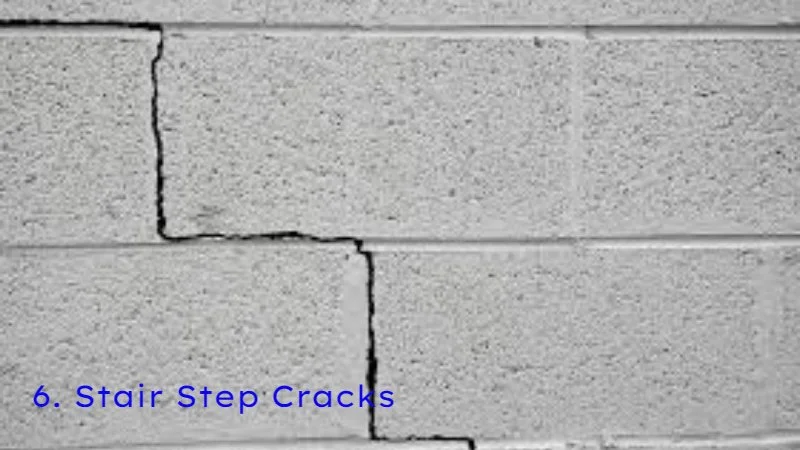
Stair-step cracks form a zigzag pattern, typically extending from walls to ceilings.
Causes:
- Foundation Shifting: Common in areas with clay soils, such as parts of London and the South East.
- Poor Drainage: Water pooling around foundations exacerbates soil movement.
Risk Level:
High. These cracks often signify serious foundational issues.
Solutions:
- Improve drainage to reduce soil movement.
- Hire a structural engineer to assess and stabilize the foundation.
- Repair cracks with professional techniques, such as underpinning or sealing.
7. Bowed Ceiling Cracks
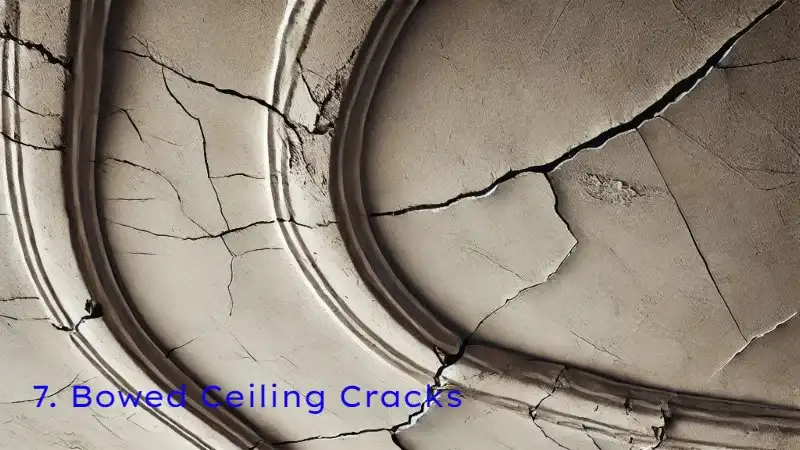
Bowed cracks occur in ceilings that sag or bulge, often appearing perpendicular to the sagging section.
Causes:
- Overloading: Heavy storage in lofts or attics places stress on ceilings.
- Water Damage: Persistent leaks weaken ceiling materials.
Risk Level:
High. These cracks indicate compromised structural integrity and require immediate action.
Solutions:
- Remove excessive weight from the affected area.
- Repair leaks and replace damaged materials.
- Reinforce the ceiling with additional joists or supports.
8. Cracks Around Fixtures
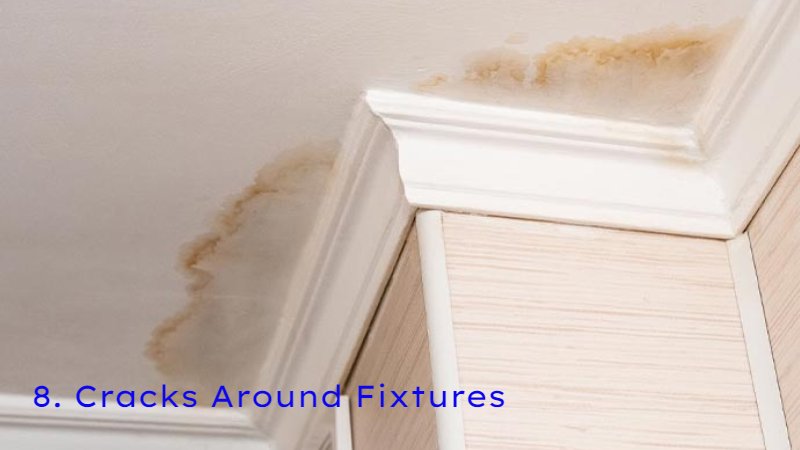
Cracks around ceiling fixtures, such as lights or vents, are small and confined to the immediate area.
Causes:
- Shifting Fixtures: Loose or improperly installed fixtures cause stress around their edges.
- Material Settling: The movement of ceiling materials around fixed points creates cracks.
Risk Level:
Medium. While often cosmetic, cracks can worsen if the fixture continues to shift.
Solutions:
- Secure fixtures properly to prevent further movement.
- Fill cracks with joint compound and repaint.
- Inspect for additional stress points around the fixture.
9. Peeling Ceiling Cracks
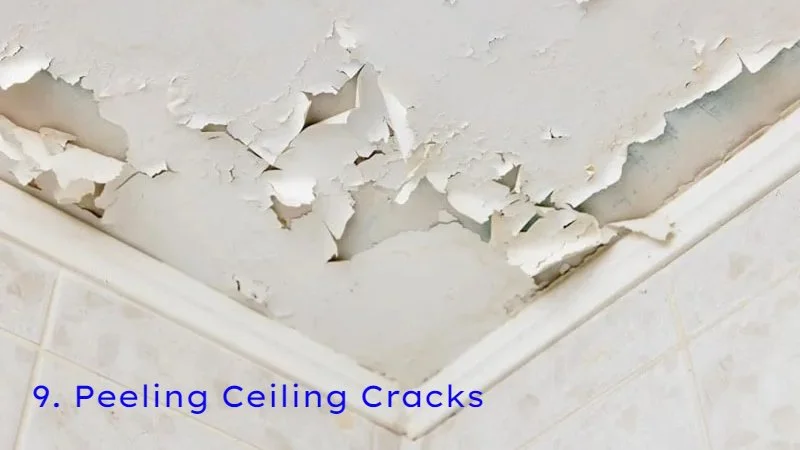
Peeling cracks are accompanied by flaking paint or plaster and are common in high-humidity environments.
Causes:
- Moisture Buildup: Poor ventilation in bathrooms and kitchens allows moisture to weaken ceiling surfaces.
- Water Leaks: Leaks from plumbing or roofs deteriorate plaster and paint.
Risk Level:
Medium. Moisture can lead to mold growth, posing health risks.
Solutions:
- Improve ventilation with extractor fans or dehumidifiers.
- Repair leaks promptly to prevent further damage.
- Treat mold, scrape away damaged materials, and repaint with moisture-resistant paint.
10. Dangerous Ceiling Cracks
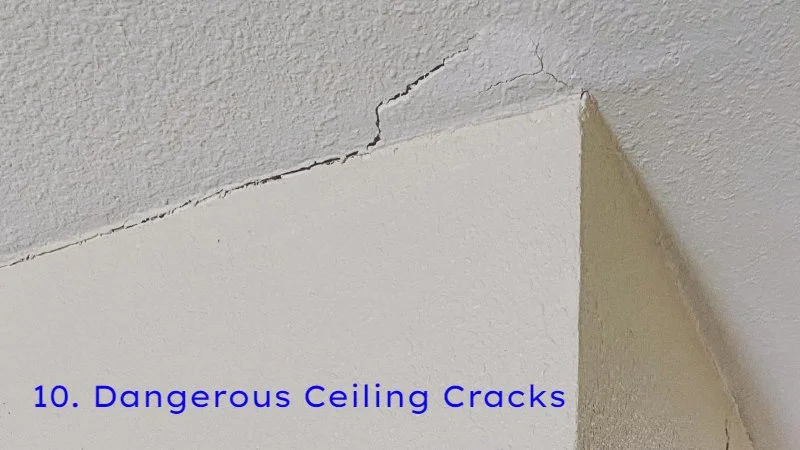
Dangerous cracks are wide, rapidly expanding, and often accompanied by sagging or structural deformation.
Causes:
- Foundation Failure: Subsidence or soil erosion can cause major structural shifts.
- Excessive Load: Overloading above ceilings or roof failures exacerbates stress.
Risk Level:
Very High. These cracks pose an immediate safety risk and require urgent professional evaluation.
Solutions:
- Consult a structural engineer immediately.
- Reinforce or replace affected structural components.
- Address foundational issues to prevent further damage.
Factors Contributing to Types of Ceiling Cracks with Pictures
- Climate: The UK’s damp and variable weather conditions contribute to moisture issues and material expansion.
- Soil Types: Clay-heavy soils in many regions lead to foundational movement and cracking.
- Property Age: The prevalence of historic buildings with lath-and-plaster ceilings increases the likelihood of cracks.
- Building Standards: Variations in construction techniques over the decades can result in differing susceptibility to cracks.
How to Prevent Ceiling Cracks
- Regular Maintenance: Inspect your home periodically for signs of cracks, leaks, or structural stress.
- Ventilation: Ensure proper airflow in high-humidity areas to reduce moisture buildup.
- Foundation Care: Address drainage issues and soil movement around your property.
- Avoid Overloading: Refrain from placing heavy loads in lofts or attics.
- Professional Inspections: Have your home evaluated by experts if you notice persistent or severe cracks.
Conclusion
Understanding the types of ceiling cracks with pictures allows UK homeowners to assess their severity and take appropriate action. While some cracks are purely cosmetic, others can indicate significant structural issues. Regular monitoring, timely repairs, and professional consultations can prevent minor cracks from escalating into costly problems. By identifying and addressing cracks promptly, you can ensure the safety, stability, and longevity of your home.

